-
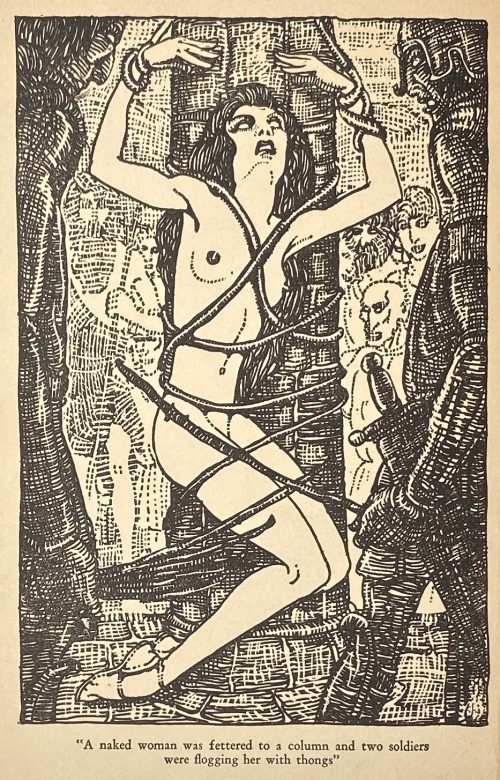 Title (in a frame): THE TEMPTATION | OF ST. ANTHONY | BY | GUSTAVE FLAUBERT | TRANSLATED BY | LAFCADIO HEARN | ILLUSTRATED BY | MAHLON BLAINE | {vignette} | NEW YORK | WILLIAMS, BELASCO | AND MEYERS || Pagination: ffl, [1, 2 - ht, blank] [2 - blank, frontis.] [3, 4 - t.p., colophon] [5, 6 - plate, blank] [7, 8 - list of ill., blank] [9 'argument'] 10-189 [190] bfl; frontispiece and 4 plates reproduced from Blaine's pen drawings in "woodcut" manner. Binding:25.5 x 17 cm., original black cloth, front cover and spine stamped in gilt; printed on thick paper, margins trimmed unevenly; pink pictorial DJ. Contributors: Gustave Flaubert (French, 1821 – 1880) – author. Mahlon Blaine (American, 1894 – 1969) – artist. Patrick Lafcadio Hearn [Koizumi Yakumo; 小泉 八雲] ( Greek-Irish, 1850 – 1904) – translator. Williams, Belasco and Meyers – publisher. J. J. Little & Ives, Co., NY – printer.
Title (in a frame): THE TEMPTATION | OF ST. ANTHONY | BY | GUSTAVE FLAUBERT | TRANSLATED BY | LAFCADIO HEARN | ILLUSTRATED BY | MAHLON BLAINE | {vignette} | NEW YORK | WILLIAMS, BELASCO | AND MEYERS || Pagination: ffl, [1, 2 - ht, blank] [2 - blank, frontis.] [3, 4 - t.p., colophon] [5, 6 - plate, blank] [7, 8 - list of ill., blank] [9 'argument'] 10-189 [190] bfl; frontispiece and 4 plates reproduced from Blaine's pen drawings in "woodcut" manner. Binding:25.5 x 17 cm., original black cloth, front cover and spine stamped in gilt; printed on thick paper, margins trimmed unevenly; pink pictorial DJ. Contributors: Gustave Flaubert (French, 1821 – 1880) – author. Mahlon Blaine (American, 1894 – 1969) – artist. Patrick Lafcadio Hearn [Koizumi Yakumo; 小泉 八雲] ( Greek-Irish, 1850 – 1904) – translator. Williams, Belasco and Meyers – publisher. J. J. Little & Ives, Co., NY – printer. -
 Uncut fan print (uchiwa-e) with the design of kabuki actor Nakamura Utaemon IV who held the name of Nakamura Shikan II from the 11th lunar month of 1825 to the 12th lunar month of 1835, dressed in a checkered kimono, holding a pipe and surrounded by flying fireflies. Character: Nakamura Utaemon IV [中村歌右衛門] (Japanese, 1796 – 1852); other names: Nakamura Shikan II, Nakamura Tsurusuke I, Nakamura Tōtarō. Series title: Catching fireflies in the floating world [浮世蛍狩] (Ukiyo hotarugari). Artist: Utagawa Kunisada [歌川 国貞], a.k.a. Toyokuni III (Japanese, 1786 – 1865). Signed: Kōchōrō Kunisada ga [香蝶楼国貞画] in a red cartouche. Publisher: Ibaya Kyubei [伊場屋 久兵衛] (Japanese, fl. 1804 – 1851); seal: modified Marks 19-009 | 126d. Censor's seal: Kiwame Date seal: Tenpō 2 (1831). Ref: Kunisada.de, N58. A look-alike yearlier Kunisada's design can be found at kunisada.de, ref. # N120-Z0172-410:
Uncut fan print (uchiwa-e) with the design of kabuki actor Nakamura Utaemon IV who held the name of Nakamura Shikan II from the 11th lunar month of 1825 to the 12th lunar month of 1835, dressed in a checkered kimono, holding a pipe and surrounded by flying fireflies. Character: Nakamura Utaemon IV [中村歌右衛門] (Japanese, 1796 – 1852); other names: Nakamura Shikan II, Nakamura Tsurusuke I, Nakamura Tōtarō. Series title: Catching fireflies in the floating world [浮世蛍狩] (Ukiyo hotarugari). Artist: Utagawa Kunisada [歌川 国貞], a.k.a. Toyokuni III (Japanese, 1786 – 1865). Signed: Kōchōrō Kunisada ga [香蝶楼国貞画] in a red cartouche. Publisher: Ibaya Kyubei [伊場屋 久兵衛] (Japanese, fl. 1804 – 1851); seal: modified Marks 19-009 | 126d. Censor's seal: Kiwame Date seal: Tenpō 2 (1831). Ref: Kunisada.de, N58. A look-alike yearlier Kunisada's design can be found at kunisada.de, ref. # N120-Z0172-410:
Actor Onoe Baikō, artist Kunisada, publisher Ibaya Kyūbei, c. 1820.
-
![George Cruikshank. George Cruikshank's Fairy Library. Hop-O'-My Thumb. Jack and the Bean-Stalk. Cinderella. Puss in Boots. — London: George Bell and Sons, 1885. — pp.: [2] blank, [2] first half-title with blank verso, [i-ii] second half-title with blank verso, [2] frontispiece plate with blank recto, [iii-viii] title, colophone, editor's note, list of illustr. [2] title with blank verso, [1] 2-101 [3] blank, 24 plates with protective tissue, unpag. — Colophon: This edition is limited to 500 copies, with India paper impressions. The former editions have been from lithographic transfers. The plates were retouched under Mr. Cruikshank's direction shortly before his death, and have not been used since until now.](https://varshavskycollection.com/wp-content/uploads/2021/02/LIB-2454.2020-f-1-500x659.jpeg) Title: GEORGE CRUIKSHANK'S FAIRY LIBRARY. | HOP-O'-MY THUMB. | JACK AND THE BEAN-STALK. | CINDERELLA. | PUSS IN BOOTS. | [DEVICE] | LONDON: | GEORGE BELL AND SONS, YORK STREET, COVENT GARDEN. Pagination: [2] – blanks, [2] – first half-title with blank verso, [i-ii] – second half-title with blank verso, [2] – blank / frontispiece, [iii-viii] title, colophon, editor's note, list of illustrations, [2] – title with blank verso, [1] 2-101 [3] – blank; 24 plates with protective tissue. Colophon: This edition is limited to 500 copies, with India paper impressions. The former editions have been from lithographic transfers. The plates were retouched under Mr. Cruikshank's direction shortly before his death, and have not been used since until now. Binding: 4to, 22.2 x 17.5 cm, hardcover; 3/4 black calf ruled in gilt, brown calf spine with raised bands decorated in gilt, with gilt title lettering. Green marbled boards and end-papers. Abel E. Berland's bookplate pasted to front pastedown. Professionally rebound, re-backed with the original spine laid down, corners bumped. Catalogue Raisonné: Not in Alan M. Cohen's. As writes the British Library: "George Cruikshank’s [...] illustrations for the first English translation of Grimm’s Fairy Tales were praised widely, but his own rewriting of fairytales was criticised, most prominently by Charles Dickens. This was not due to the quality of the illustrations, but because, in line with his temperance beliefs, Cruikshank rewrote aspects of the fairytales to warn the reader against the evils of alcohol. Thus, for instance, the preparations for Cinderella’s marriage include the court throwing all alcohol in the palace on a bonfire; and in ‘Jack and the Beanstalk’, the giant is an alcoholic. Dickens, a friend of Cruikshank, was outraged at what he considered to be a betrayal of the essence of fairytales and, in protest, he published an essay in his weekly magazine Household Words entitled ‘Frauds on the Fairies’ in protest (1853)."
Title: GEORGE CRUIKSHANK'S FAIRY LIBRARY. | HOP-O'-MY THUMB. | JACK AND THE BEAN-STALK. | CINDERELLA. | PUSS IN BOOTS. | [DEVICE] | LONDON: | GEORGE BELL AND SONS, YORK STREET, COVENT GARDEN. Pagination: [2] – blanks, [2] – first half-title with blank verso, [i-ii] – second half-title with blank verso, [2] – blank / frontispiece, [iii-viii] title, colophon, editor's note, list of illustrations, [2] – title with blank verso, [1] 2-101 [3] – blank; 24 plates with protective tissue. Colophon: This edition is limited to 500 copies, with India paper impressions. The former editions have been from lithographic transfers. The plates were retouched under Mr. Cruikshank's direction shortly before his death, and have not been used since until now. Binding: 4to, 22.2 x 17.5 cm, hardcover; 3/4 black calf ruled in gilt, brown calf spine with raised bands decorated in gilt, with gilt title lettering. Green marbled boards and end-papers. Abel E. Berland's bookplate pasted to front pastedown. Professionally rebound, re-backed with the original spine laid down, corners bumped. Catalogue Raisonné: Not in Alan M. Cohen's. As writes the British Library: "George Cruikshank’s [...] illustrations for the first English translation of Grimm’s Fairy Tales were praised widely, but his own rewriting of fairytales was criticised, most prominently by Charles Dickens. This was not due to the quality of the illustrations, but because, in line with his temperance beliefs, Cruikshank rewrote aspects of the fairytales to warn the reader against the evils of alcohol. Thus, for instance, the preparations for Cinderella’s marriage include the court throwing all alcohol in the palace on a bonfire; and in ‘Jack and the Beanstalk’, the giant is an alcoholic. Dickens, a friend of Cruikshank, was outraged at what he considered to be a betrayal of the essence of fairytales and, in protest, he published an essay in his weekly magazine Household Words entitled ‘Frauds on the Fairies’ in protest (1853)." -
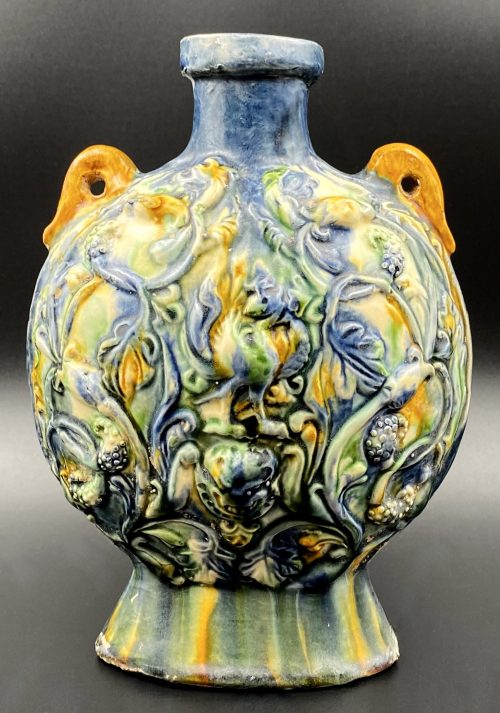 A vessel of flattened ovoid form supported on a tall splayed foot and surmounted by a short neck with the galleried rim. The shoulders set with a pair of loop handles, the body moulded on both sides with a Phenix surrounded with meandering floral and foliate scrolls. Covered with irregular splashes of green, amber, cream, and blue glazes, dripping down the foot. Foot bottom unglazed (beige body). China, the Tang dynasty [唐朝] (618 – 907). Height: 18.5 cm; Width: 13 cm
A vessel of flattened ovoid form supported on a tall splayed foot and surmounted by a short neck with the galleried rim. The shoulders set with a pair of loop handles, the body moulded on both sides with a Phenix surrounded with meandering floral and foliate scrolls. Covered with irregular splashes of green, amber, cream, and blue glazes, dripping down the foot. Foot bottom unglazed (beige body). China, the Tang dynasty [唐朝] (618 – 907). Height: 18.5 cm; Width: 13 cm -
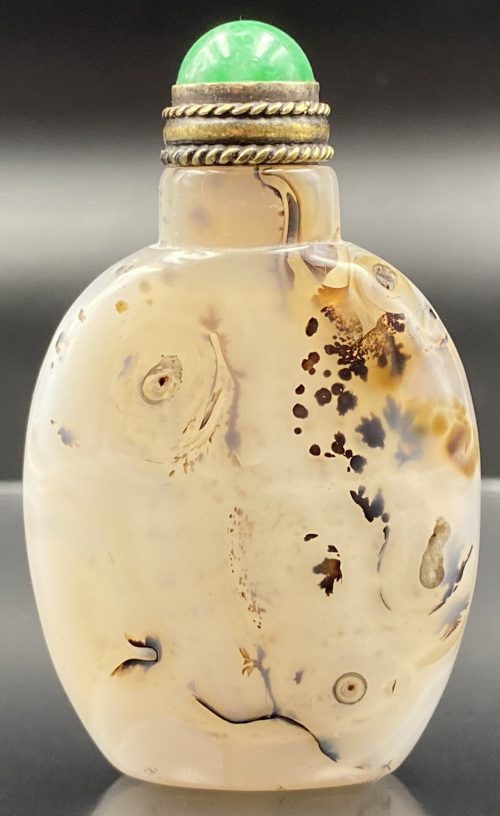 Agate snuff bottle of flattened rounded rectangular form, round neck, and flat base, semitransparent milky white body with dark brown inclusions of geometric form. Green jadeite stopper with a copper alloy spoon and collar. Qing dynasty [清] (1644-1912) Size: 7.2 x 4.3 x 2.2 cm
Agate snuff bottle of flattened rounded rectangular form, round neck, and flat base, semitransparent milky white body with dark brown inclusions of geometric form. Green jadeite stopper with a copper alloy spoon and collar. Qing dynasty [清] (1644-1912) Size: 7.2 x 4.3 x 2.2 cm -
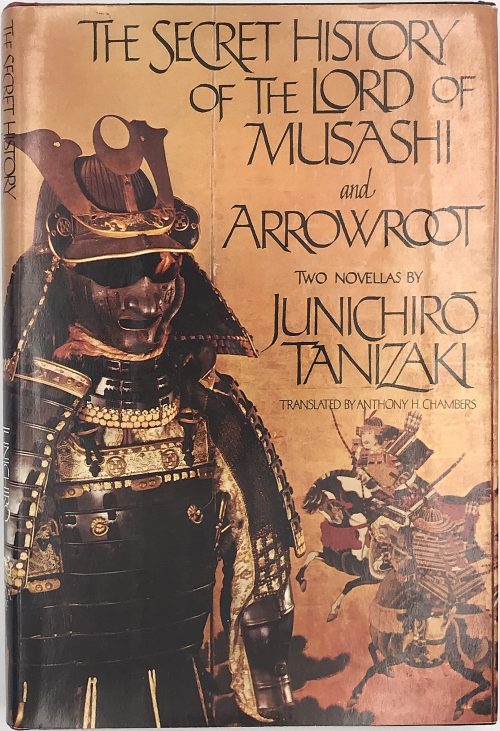 Hardcover, 22 x 15 cm; publisher's quarter burgundy cloth, gilt lettering to cover and spine, pictorial DJ. Stated 1st edition. Translation of Bushōkō Hiwa (The Secret History of the Lord of Musashi) and Yoshino Kuzu (Arrowroot). ISBN: 9780394524542
Hardcover, 22 x 15 cm; publisher's quarter burgundy cloth, gilt lettering to cover and spine, pictorial DJ. Stated 1st edition. Translation of Bushōkō Hiwa (The Secret History of the Lord of Musashi) and Yoshino Kuzu (Arrowroot). ISBN: 9780394524542 -
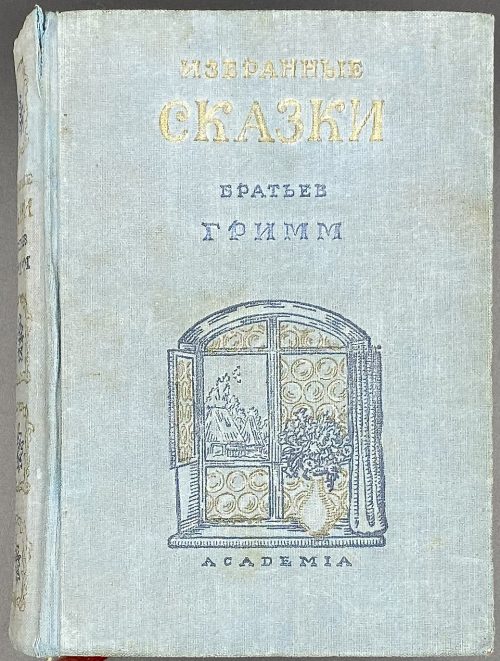 Title: ИЗБРАННЫЕ | СКАЗКИ | БРАТЬЕВ ГРИММ | Перевод | Григория Петникова | {device} | ACADEMIA | Москва—Ленинград | 1937 || Title verso: Kinder- und Hausmärchen | gesammelt durch die | Brüder Grimm | иллюстрации с рисунков Ракхама 1900 г. | Переплет, контр-титул, фронтиспис, заставка и концовка А. Д. Силина. Pagination: [1-4] 5-634 [2] ; b/w illustrations in text, 2 colour plates. Collation: 8vo; [1]8 2-398 406. Print run: 15,300 copies. Binding: publisher’s blue cloth stamped with lettering and elements of design to cover and spine, pictorial endleaves. Петников, Григорий Николаевич (Russian, 1894 – 1971) Силин, Александр Дмитриевич (Russian, 1883 – 1942)
Title: ИЗБРАННЫЕ | СКАЗКИ | БРАТЬЕВ ГРИММ | Перевод | Григория Петникова | {device} | ACADEMIA | Москва—Ленинград | 1937 || Title verso: Kinder- und Hausmärchen | gesammelt durch die | Brüder Grimm | иллюстрации с рисунков Ракхама 1900 г. | Переплет, контр-титул, фронтиспис, заставка и концовка А. Д. Силина. Pagination: [1-4] 5-634 [2] ; b/w illustrations in text, 2 colour plates. Collation: 8vo; [1]8 2-398 406. Print run: 15,300 copies. Binding: publisher’s blue cloth stamped with lettering and elements of design to cover and spine, pictorial endleaves. Петников, Григорий Николаевич (Russian, 1894 – 1971) Силин, Александр Дмитриевич (Russian, 1883 – 1942) -
![Memoirs, Illustrating the History of Jacobinism, written in French by the Abbé Barruel, And Translated into English by the Hon. Robert Clifford, F. R. S. & A. S. / 2nd edition, revised and corrected. Printed for the Translator. — T. Burton. London, 1798. — Vol. 1-4. Vol. 1: Part I. The Antichristian Conspiracy: pp. (xvi) 401; Vol. 2: Part II. The Antimonarchical Conspiracy: pp.479; Vol. 3: Part III. The Antisocial Conspiracy: pp. (xviii) 414; Vol. 4: Part IV. Antisocial Conspiracy; Historical Part: pp. (xviii) 601 [50].](https://varshavskycollection.com/wp-content/uploads/2021/02/LIB-2195.2019-500x796.jpeg) Vol. 1. PART I. | THE ANTICHRISTIAN CONSPIRACY. || Title page: MEMOIRS, | Illustrating the | HISTORY of JACOBINISM, | Written in French by | THE ABBÉ BARRUEL, | And translated into English by | THE HON. ROBERT CLIFFORD, F. R. S. & A. S. | — | Princes and Nations shall disappear from the face of the Earth… and this | REVOLUTION shall be the WORK OF SECRET SOCIETIES. | Weishaupt’s Discourse for the Mysteries. | — | PART I. | THE ANTICHRISTIAN CONSPIRACY. | Second Edition, revised and corrected. | LONDON: | Printed for the Translator, | By T. Burton, No. 11 Gate-street, Lincoln’s-Inn Fields. | Sold by E. Booker, No. 56, New Bond-street. | 1798. || Pagination: [2] – t.p. / imprint, [2] – contents / contents, [i] ii-xvi, [1] 2-401 [402 blank]. Collation : 2 blank leaves, π2 b8, B-Z8 Aa-Bb8 Cc9, 2 blank leaves. Vol. 2: Same as Vol. 1, but: PART II. THE ANTIMONARCHICAL CONSPIRACY. || Pagination: [2] – t.p. / imprint, [2] – contents / contents, [1] 2-479 [480 blank]. Collation: 2 blank leaves, π2 B-Z8 Aa-Gg8 Hh3, 2 blank leaves. Vol. 3.: Same as Vol. 1, but: PART III. THE ANTISOCIAL CONSPIRACY. || Pagination: [i,ii] – t.p. / imprint, [iii] iv-xviii, [1] 2-414; one plate. Collation : 2 blank leaves, π1 A-Z8 Aa-Cc8 D7. Vol. 4: PART IV. ANTISOCIAL CONSPIRACY; HISTORICAL PART. || Pagination: [i,ii] – t.p. / imprint, iii-xviii, [1] 2-601 [602 blank], [1] 2-50; one folding plate. Collation: 2 blank leaves, a8 B-Z8 Aa-Pp8 Qq5, a-c8 d1. Binding: All four volumes uniformly bound in full polished calf, gilt roll-and-rule border, black and green labels with gilt lettering, gilt filigree to spine; marbled endpapers and all edges; printed on wove paper, with long “s”. The original French title: Mémoires pour servir à l'histoire du Jacobinisme par M. l'abbé Barruel. Author: Augustin Barruel (French, 1741 – 1820). Translator: The Honourable Robert Edward Clifford (British, 1767 – 1817). LIB-2195-1.2019; LIB-2195-2.2019; LIB-2195-3.2019; LIB-2195-4.2019.
Vol. 1. PART I. | THE ANTICHRISTIAN CONSPIRACY. || Title page: MEMOIRS, | Illustrating the | HISTORY of JACOBINISM, | Written in French by | THE ABBÉ BARRUEL, | And translated into English by | THE HON. ROBERT CLIFFORD, F. R. S. & A. S. | — | Princes and Nations shall disappear from the face of the Earth… and this | REVOLUTION shall be the WORK OF SECRET SOCIETIES. | Weishaupt’s Discourse for the Mysteries. | — | PART I. | THE ANTICHRISTIAN CONSPIRACY. | Second Edition, revised and corrected. | LONDON: | Printed for the Translator, | By T. Burton, No. 11 Gate-street, Lincoln’s-Inn Fields. | Sold by E. Booker, No. 56, New Bond-street. | 1798. || Pagination: [2] – t.p. / imprint, [2] – contents / contents, [i] ii-xvi, [1] 2-401 [402 blank]. Collation : 2 blank leaves, π2 b8, B-Z8 Aa-Bb8 Cc9, 2 blank leaves. Vol. 2: Same as Vol. 1, but: PART II. THE ANTIMONARCHICAL CONSPIRACY. || Pagination: [2] – t.p. / imprint, [2] – contents / contents, [1] 2-479 [480 blank]. Collation: 2 blank leaves, π2 B-Z8 Aa-Gg8 Hh3, 2 blank leaves. Vol. 3.: Same as Vol. 1, but: PART III. THE ANTISOCIAL CONSPIRACY. || Pagination: [i,ii] – t.p. / imprint, [iii] iv-xviii, [1] 2-414; one plate. Collation : 2 blank leaves, π1 A-Z8 Aa-Cc8 D7. Vol. 4: PART IV. ANTISOCIAL CONSPIRACY; HISTORICAL PART. || Pagination: [i,ii] – t.p. / imprint, iii-xviii, [1] 2-601 [602 blank], [1] 2-50; one folding plate. Collation: 2 blank leaves, a8 B-Z8 Aa-Pp8 Qq5, a-c8 d1. Binding: All four volumes uniformly bound in full polished calf, gilt roll-and-rule border, black and green labels with gilt lettering, gilt filigree to spine; marbled endpapers and all edges; printed on wove paper, with long “s”. The original French title: Mémoires pour servir à l'histoire du Jacobinisme par M. l'abbé Barruel. Author: Augustin Barruel (French, 1741 – 1820). Translator: The Honourable Robert Edward Clifford (British, 1767 – 1817). LIB-2195-1.2019; LIB-2195-2.2019; LIB-2195-3.2019; LIB-2195-4.2019. -
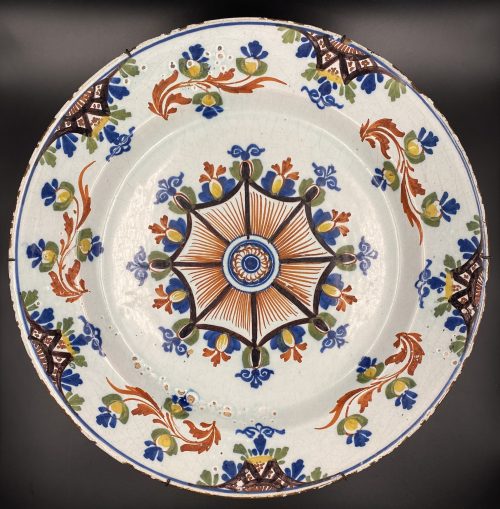 Round plate with an underglaze polychrome design of a blue border and stylized flowers on the rim and octagonal ornament at the centre. Diameter: 34 cm, Haight: 4 cm.
Round plate with an underglaze polychrome design of a blue border and stylized flowers on the rim and octagonal ornament at the centre. Diameter: 34 cm, Haight: 4 cm. -
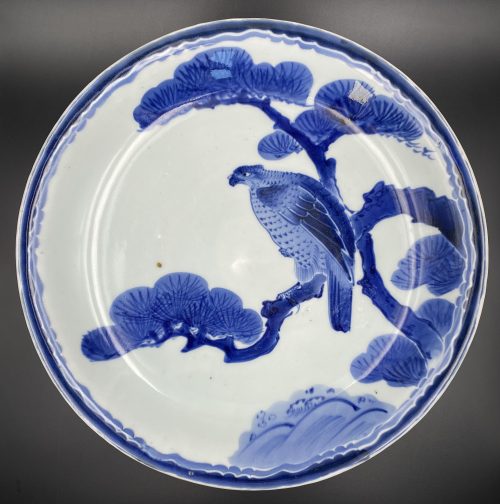 Underglaze cobalt blue and white porcelain plate decorated with a falcon on a pine tree and rough waves beneath; rim with a stylized wave design; seven spur marks on the reverse. Diameter: 31 cm; Height: 5 cm; Diameter of the foot: 18 cm.
Underglaze cobalt blue and white porcelain plate decorated with a falcon on a pine tree and rough waves beneath; rim with a stylized wave design; seven spur marks on the reverse. Diameter: 31 cm; Height: 5 cm; Diameter of the foot: 18 cm. -
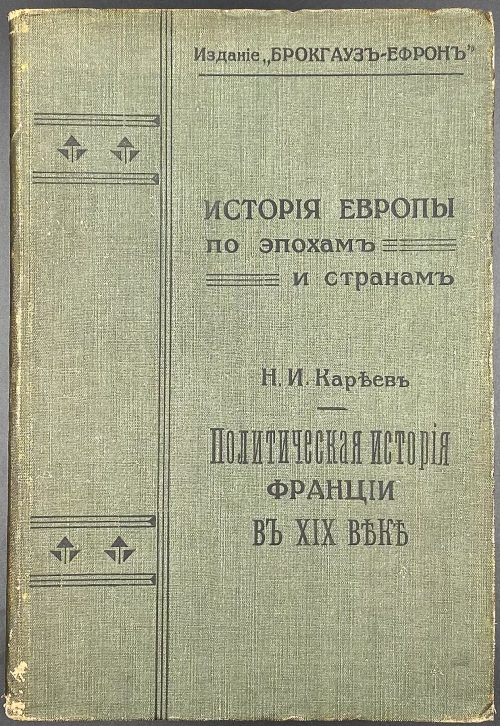 Cover: Изданiе "БРОКГАУЗЪ-ЕФРОНЪ" | ИСТОРIЯ ЕВРОПЫ | ПО ЭПОХАМЪ | И СТРАНАМЪ | Н. И. Карѣевъ | ПОЛИТИЧЕСКАЯ ИСТОРIЯ | ФРАНЦIИ | ВЪ XIX ВѢКѢ || Title page: Исторiя Европы по эпохамъ и странамъ в среднiе вѣка и новое время. | Изд. под. ред. Н. И. Карѣева и И. В. Лучицкаго. | Н. И. КАРѢЕВЪ | ПОЛИТИЧЕСКАЯ | ИСТОРIЯ ФРАНЦIИ | ВЪ XIX ВѢКѢ. | (Правительственныя формы и внутренняя политика, политическiя партiи | и общественные классы). | Изданiе Акц. Общ. "Брокгаузъ-Ефронъ". | С.-ПЕТЕРБУРГЪ. | Типографiя Акц. Общ. Брокгаузъ-Ефронъ. Прачешный пер. № 6. | 1902. || Pagination: [2] – title / blank, [i-iii] iv-v [vi], [1] 2-300 +1 colour plate (maps). Collation: 8vo; [π]4 1-188 196 + 1 leaf (maps). Binding: Publisher’s green cloth with black lettering to spine and cover, design elements to cover. Contributors: Кареев, Николай Иванович (Russian, 1850 – 1931) – author.
Cover: Изданiе "БРОКГАУЗЪ-ЕФРОНЪ" | ИСТОРIЯ ЕВРОПЫ | ПО ЭПОХАМЪ | И СТРАНАМЪ | Н. И. Карѣевъ | ПОЛИТИЧЕСКАЯ ИСТОРIЯ | ФРАНЦIИ | ВЪ XIX ВѢКѢ || Title page: Исторiя Европы по эпохамъ и странамъ в среднiе вѣка и новое время. | Изд. под. ред. Н. И. Карѣева и И. В. Лучицкаго. | Н. И. КАРѢЕВЪ | ПОЛИТИЧЕСКАЯ | ИСТОРIЯ ФРАНЦIИ | ВЪ XIX ВѢКѢ. | (Правительственныя формы и внутренняя политика, политическiя партiи | и общественные классы). | Изданiе Акц. Общ. "Брокгаузъ-Ефронъ". | С.-ПЕТЕРБУРГЪ. | Типографiя Акц. Общ. Брокгаузъ-Ефронъ. Прачешный пер. № 6. | 1902. || Pagination: [2] – title / blank, [i-iii] iv-v [vi], [1] 2-300 +1 colour plate (maps). Collation: 8vo; [π]4 1-188 196 + 1 leaf (maps). Binding: Publisher’s green cloth with black lettering to spine and cover, design elements to cover. Contributors: Кареев, Николай Иванович (Russian, 1850 – 1931) – author. -
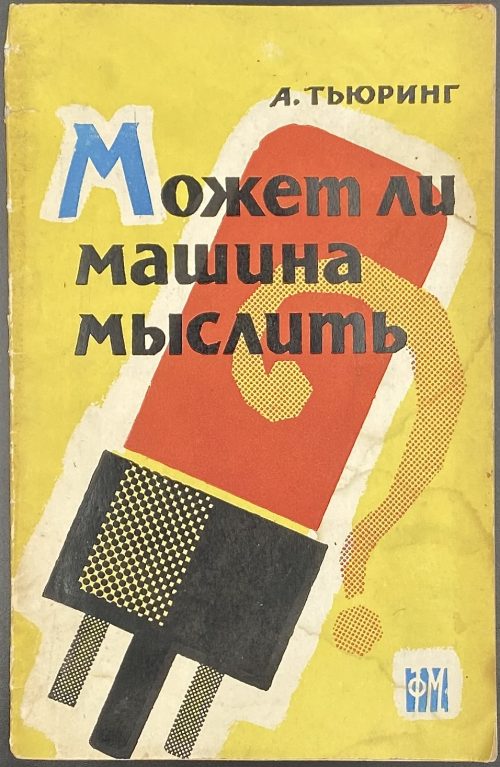 А. Тьюринг. Может ли машина мыслить? / С прил. ст. Дж. фон Неймана "Общая и логическая теория автоматов"; пер. с англ. Ю. А. Данилова; ред. и пред. С. А. Яновской. — М.: Физматгиз, 1960. Title page: А. ТЬЮРИНГ | МОЖЕТ ЛИ | МАШИНА МЫСЛИТЬ? | С приложением статьи ДЖ. фон НЕЙМАНА | ОБЩАЯ И ЛОГИЧЕСКАЯ ТЕОРИЯ АВТОМАТОВ | Перевод с английского | Ю. А. Данилова | Редакция и предисловие | проф. С. А. Яновской | {Publisher’s device «ФМ» | ГОСУДАРСТВЕННОЕ ИЗДАТЕЛЬСТВО | ФИЗИКО-МАТЕМАТИЧЕСКОЙ ЛИТЕРАТУРЫ | МОСКВА 1960 || Pagination: [2] 3-110 [2]. Collation: [1]8, 2-416; 11 (t.p./contents, imprint.) unsigned. Size: 20 x 13 cm Binding: Softcover, front pictorial wrapper – yellow background and radio lamp, lettering: А. Тьюринг. Может ли | машина | мыслить | ? | {publisher's device white on blue "ФМ"} || Contributors: Turing, Alan Mathison (British, 1912 – 1954) – author of the text. John von Neumann (American-Hungarian, 1903 – 1957) – author of the text. Данилов, Юлий Александрович (Russian, 1936 – 2003) – translator. Яновская [Неймарк], Софья Александровна (Russian-Jewish, 1896 – 1966) – author of preface, editor.
А. Тьюринг. Может ли машина мыслить? / С прил. ст. Дж. фон Неймана "Общая и логическая теория автоматов"; пер. с англ. Ю. А. Данилова; ред. и пред. С. А. Яновской. — М.: Физматгиз, 1960. Title page: А. ТЬЮРИНГ | МОЖЕТ ЛИ | МАШИНА МЫСЛИТЬ? | С приложением статьи ДЖ. фон НЕЙМАНА | ОБЩАЯ И ЛОГИЧЕСКАЯ ТЕОРИЯ АВТОМАТОВ | Перевод с английского | Ю. А. Данилова | Редакция и предисловие | проф. С. А. Яновской | {Publisher’s device «ФМ» | ГОСУДАРСТВЕННОЕ ИЗДАТЕЛЬСТВО | ФИЗИКО-МАТЕМАТИЧЕСКОЙ ЛИТЕРАТУРЫ | МОСКВА 1960 || Pagination: [2] 3-110 [2]. Collation: [1]8, 2-416; 11 (t.p./contents, imprint.) unsigned. Size: 20 x 13 cm Binding: Softcover, front pictorial wrapper – yellow background and radio lamp, lettering: А. Тьюринг. Может ли | машина | мыслить | ? | {publisher's device white on blue "ФМ"} || Contributors: Turing, Alan Mathison (British, 1912 – 1954) – author of the text. John von Neumann (American-Hungarian, 1903 – 1957) – author of the text. Данилов, Юлий Александрович (Russian, 1936 – 2003) – translator. Яновская [Неймарк], Софья Александровна (Russian-Jewish, 1896 – 1966) – author of preface, editor. -
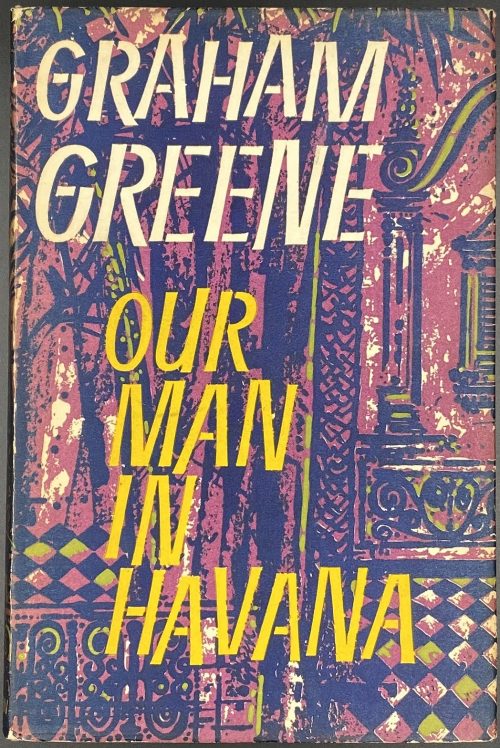 Title page: GRAHAM GREENE | {double rule} | Our Man in Havana | AN ENTERTAINMENT | {publisher’s device: windmill among the hills, letters W and H} | HEINEMANN | LONDON MELBOURNE TORONTO || Title verso: William Heinemann Ltd | LONDON MELBOURNE TORONTO | CAPE TOWN AUCKLAND | THE HAGUE | First published 1958 | © by William Heinemann Limited 1958 | All rights reserved | Printed in Great Britain | at The Windmill Press | Kingswood, Surrey || Pagination: [6] [1, 2] 3-273 [274]. Binding: 20.2 x 13.5 cm, publisher’s blue cloth, gilt lettering to spine (top): OUR | MAN | IN | HAVANA | {double rule} | GRAHAM GREENE | (bottom): HEINEMANN ||; blind-stamped publisher’s device to back cover in the lower-right corner without lettering; pp. 1-122 and 253-274 darker, than the middle pages; original dust jacket designed by Donald Green, unclipped, 15s NET in the lower-right corner of the front flap, advertisement of The quiet American on the back. Edition: 1st edition, 1st printing. Contributors: Graham Greene (British, 1904 – 1991) – author. Donald Green (British, 1919 – 1983) – DJ artist. William Henry Heinemann (British-Jewish, 1863 – 1920); William Heinemann Limited – publisher. The Windmill Press (Kingswood, Surrey) – printer.
Title page: GRAHAM GREENE | {double rule} | Our Man in Havana | AN ENTERTAINMENT | {publisher’s device: windmill among the hills, letters W and H} | HEINEMANN | LONDON MELBOURNE TORONTO || Title verso: William Heinemann Ltd | LONDON MELBOURNE TORONTO | CAPE TOWN AUCKLAND | THE HAGUE | First published 1958 | © by William Heinemann Limited 1958 | All rights reserved | Printed in Great Britain | at The Windmill Press | Kingswood, Surrey || Pagination: [6] [1, 2] 3-273 [274]. Binding: 20.2 x 13.5 cm, publisher’s blue cloth, gilt lettering to spine (top): OUR | MAN | IN | HAVANA | {double rule} | GRAHAM GREENE | (bottom): HEINEMANN ||; blind-stamped publisher’s device to back cover in the lower-right corner without lettering; pp. 1-122 and 253-274 darker, than the middle pages; original dust jacket designed by Donald Green, unclipped, 15s NET in the lower-right corner of the front flap, advertisement of The quiet American on the back. Edition: 1st edition, 1st printing. Contributors: Graham Greene (British, 1904 – 1991) – author. Donald Green (British, 1919 – 1983) – DJ artist. William Henry Heinemann (British-Jewish, 1863 – 1920); William Heinemann Limited – publisher. The Windmill Press (Kingswood, Surrey) – printer. -
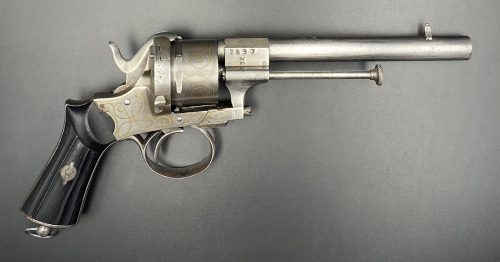 Serial number 8697, barrel 14.5 cm, calibre 9 mm Lefaucheux M-1858 double-action pin-fire revolver manufactured in the late 1860-s. Produced in France with no retailers marking but having French proofs on front of the cylinder and right side of barrel trunnion. The metal remains in the white with small gold wire inlays. Fluted 2 piece ebony grips. This pattern has been observed in civil war photographs and excavated from battlefields and camps in the United States. Dimensions: L: 25 cm; H: 13 cm; Barrel: 14.5 cm.
Serial number 8697, barrel 14.5 cm, calibre 9 mm Lefaucheux M-1858 double-action pin-fire revolver manufactured in the late 1860-s. Produced in France with no retailers marking but having French proofs on front of the cylinder and right side of barrel trunnion. The metal remains in the white with small gold wire inlays. Fluted 2 piece ebony grips. This pattern has been observed in civil war photographs and excavated from battlefields and camps in the United States. Dimensions: L: 25 cm; H: 13 cm; Barrel: 14.5 cm. -
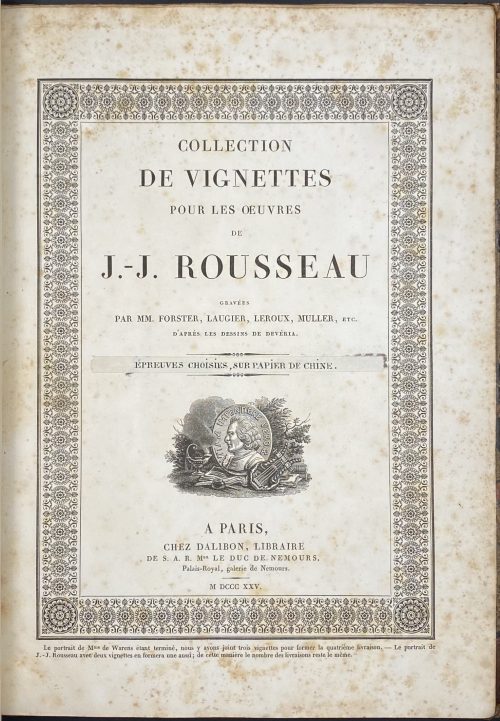 Pictorial album of 41 etchings, incl. two portraits, by various engravers after Achille Devéria, printed on India paper (after letters) and pasted on thick wove paper, bound with tissue guards in half calf over marbled boards bordered gilt, spine decorated gilt, marbled endpapers; base paper and tissue guards are substantially foxed, images mostly intact. The title page and the subscription page are bound-in at the beginning and at the end, respectively. Title page: (in ornamental frame): COLLECTION | DE VIGNETTES | POUR LES ŒUVRES | DE | J.-J. ROUSSEAU | GRAVÉES | PAR MM. FORSTER, LAUGIER, LEROUX, MULLER, ETC. | D'APRÈS LES DESSINS DE DEVÉRIA. | (pasted over) ÉPREUVES CHOISIES, SUR PAPIER DE CHINE. | {publisher’s device} | A PARIS, | CHEZ DALIBON, LIBRAIRE | DE S. A. R. MGR LE DUC DE NEMOURS, | Palais-Royal, galerie de Nemours. | M DCCC XXV. | Under the frame: Le portrait de Mme de Warens étant terminé, nous y avons joint trois vignettes pour former la quatrième livraison. — Le portrait de | J.-J. Rousseau avec deux vignettes en formera une aussi ; de cette manière le nombre des livraisons reste le même. || This collection was published by Dalibon the same year as the 25-volume Rousseau's Œuvres completes. Related persons: Jean-Jacques Rousseau (French, 1712 – 1778). Mme de Warens: Françoise-Louise de Warens [Louise Éléonore de la Tour du Pil] Swiss, 1699 – 1762). S.A.R. Mgr Le Duc de Nemours: Prince Louis of Orléans, Duke of Nemours [Louis Charles Philippe Raphaël d'Orléans] (French, 1814 – 1896). Contributors: François-Denis Dalibon (French, 1794 – 1853) – publisher. L'Imprimerie de Rignoux (Paris); Thomas-François Rignoux (1781 – 1863?) – printer. Achille Devéria (French, 1800 – 1857) – artist. Engravers : François Forster (French, 1790 – 1872) Jean Nicolas Laugier (French, 1785 – 1875) Jean Marie Leroux (French, 1788 – 1871) Henri Charles Müller (French, 1784 – 1845) Herbert König (German, 1820 – 1876) Louis Jean Désiré Delaistre (French, 1800 – 1871) Jean Louis Toussaint Caron (French, 1790 – 1832) Pierre Michel Adam (French, 1799 – 1853) Ferdinand Sébastien Goulu (French, 1796 – 1848) Jean-François Pourvoyeur (French, 1784 – 1851) Jean Baptiste Touzé (French, fl. 1810 – 1830) Narcisse Lecomte (French, 1794 – 1882) Louis Hercule Sisco (French, 1778 – 1861) Edme Jean Ruhierre (French, 1789 – fl. 1826) Auguste Thomas Marie Blanchard (French, 1819 – 1898) François Manceau (French, 1768 – after 1837) Gabriel Louis Lacour-Lestudier (French, 1800 – 1849) Fulley [Frilley?] Jean Jacques Frilley (French, 1797 – after 1850) Philippe Joseph Augustin Vallot (French, 1796 – 1870) Etienne Devilliers (French, 1784 – after 1844) Jean Bosq (French, fl. c. 1801 – 1844) Zachée Prévost (French, 1797 – 1861) Jean Baptiste Guyard II (French, 1787 – 1831/32) Antoine François Gelée (French, 1796-1860) Constant Louis Antoine Lorichon (French, 1800-1856?) Antoine Joseph Chollet (French, 1793 – after 1848) Adrien Migneret (French, 1786 – 1840) Alfred Johannot (French, 1800 – 1837) Arnold Jéhotte (French, 1789 – 1836) Hippolyte Prudhomme (French, 1793 – 1853) Achille Lefèvre (French, 1798 – 1864) Pierre Pelée (French, 1801 – 1871) Antoine [Tony] Johannot (French, 1803 – 1852) Pierre Joseph Tavernier (French, 1787 – after 1845) Leclerc (?) Levasseur (?)
Pictorial album of 41 etchings, incl. two portraits, by various engravers after Achille Devéria, printed on India paper (after letters) and pasted on thick wove paper, bound with tissue guards in half calf over marbled boards bordered gilt, spine decorated gilt, marbled endpapers; base paper and tissue guards are substantially foxed, images mostly intact. The title page and the subscription page are bound-in at the beginning and at the end, respectively. Title page: (in ornamental frame): COLLECTION | DE VIGNETTES | POUR LES ŒUVRES | DE | J.-J. ROUSSEAU | GRAVÉES | PAR MM. FORSTER, LAUGIER, LEROUX, MULLER, ETC. | D'APRÈS LES DESSINS DE DEVÉRIA. | (pasted over) ÉPREUVES CHOISIES, SUR PAPIER DE CHINE. | {publisher’s device} | A PARIS, | CHEZ DALIBON, LIBRAIRE | DE S. A. R. MGR LE DUC DE NEMOURS, | Palais-Royal, galerie de Nemours. | M DCCC XXV. | Under the frame: Le portrait de Mme de Warens étant terminé, nous y avons joint trois vignettes pour former la quatrième livraison. — Le portrait de | J.-J. Rousseau avec deux vignettes en formera une aussi ; de cette manière le nombre des livraisons reste le même. || This collection was published by Dalibon the same year as the 25-volume Rousseau's Œuvres completes. Related persons: Jean-Jacques Rousseau (French, 1712 – 1778). Mme de Warens: Françoise-Louise de Warens [Louise Éléonore de la Tour du Pil] Swiss, 1699 – 1762). S.A.R. Mgr Le Duc de Nemours: Prince Louis of Orléans, Duke of Nemours [Louis Charles Philippe Raphaël d'Orléans] (French, 1814 – 1896). Contributors: François-Denis Dalibon (French, 1794 – 1853) – publisher. L'Imprimerie de Rignoux (Paris); Thomas-François Rignoux (1781 – 1863?) – printer. Achille Devéria (French, 1800 – 1857) – artist. Engravers : François Forster (French, 1790 – 1872) Jean Nicolas Laugier (French, 1785 – 1875) Jean Marie Leroux (French, 1788 – 1871) Henri Charles Müller (French, 1784 – 1845) Herbert König (German, 1820 – 1876) Louis Jean Désiré Delaistre (French, 1800 – 1871) Jean Louis Toussaint Caron (French, 1790 – 1832) Pierre Michel Adam (French, 1799 – 1853) Ferdinand Sébastien Goulu (French, 1796 – 1848) Jean-François Pourvoyeur (French, 1784 – 1851) Jean Baptiste Touzé (French, fl. 1810 – 1830) Narcisse Lecomte (French, 1794 – 1882) Louis Hercule Sisco (French, 1778 – 1861) Edme Jean Ruhierre (French, 1789 – fl. 1826) Auguste Thomas Marie Blanchard (French, 1819 – 1898) François Manceau (French, 1768 – after 1837) Gabriel Louis Lacour-Lestudier (French, 1800 – 1849) Fulley [Frilley?] Jean Jacques Frilley (French, 1797 – after 1850) Philippe Joseph Augustin Vallot (French, 1796 – 1870) Etienne Devilliers (French, 1784 – after 1844) Jean Bosq (French, fl. c. 1801 – 1844) Zachée Prévost (French, 1797 – 1861) Jean Baptiste Guyard II (French, 1787 – 1831/32) Antoine François Gelée (French, 1796-1860) Constant Louis Antoine Lorichon (French, 1800-1856?) Antoine Joseph Chollet (French, 1793 – after 1848) Adrien Migneret (French, 1786 – 1840) Alfred Johannot (French, 1800 – 1837) Arnold Jéhotte (French, 1789 – 1836) Hippolyte Prudhomme (French, 1793 – 1853) Achille Lefèvre (French, 1798 – 1864) Pierre Pelée (French, 1801 – 1871) Antoine [Tony] Johannot (French, 1803 – 1852) Pierre Joseph Tavernier (French, 1787 – after 1845) Leclerc (?) Levasseur (?) -
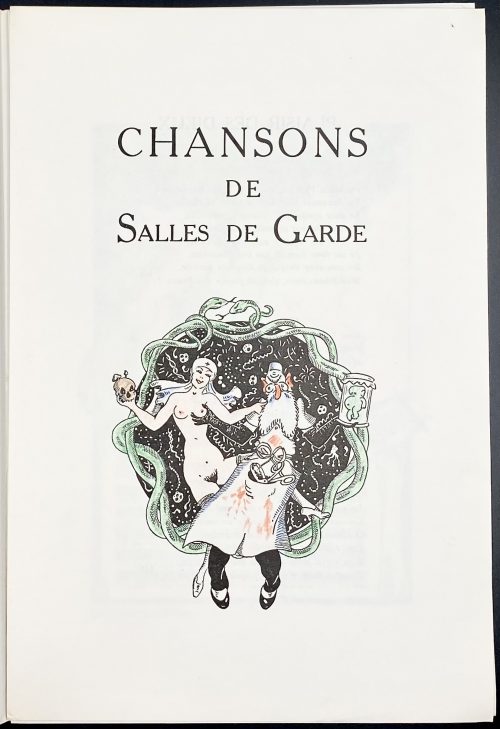 Title-page: CHANSONS | DE | SALLES DE GARDE | {vignette} || Description: 27.5 x 18.5 cm, in pictorial French flapped wrapper and in a green cloth folder, vertically lettered to spine “CHANSONS” in black letters, a flute benith. Pagination: [1-3] 4-140 [4] plus 52 plates extraneous to collation (Dutel provides for 142 pp.) Illustrations: plates, headbands, vignettes to front wrapper, title-page and limitation page, as well as the vignette at the end, reproduced after drawings by Morvan (according to J.-P. Dutel) and hand-coloured with crayons (the question remains, is it Hervé Morvan, French, 1917 – 1980?) Limitation: 950 copies of which 25 marked A to Z; 25 copies consist of an additional suite and one original drawing (№ 1-25); 25 copies have an original drawing (№ 26-50), and 875 copies numbered 51 to 950. This copy is № 697. Catalogue raisonné: Dutel (1920-1970): № 1186.
Title-page: CHANSONS | DE | SALLES DE GARDE | {vignette} || Description: 27.5 x 18.5 cm, in pictorial French flapped wrapper and in a green cloth folder, vertically lettered to spine “CHANSONS” in black letters, a flute benith. Pagination: [1-3] 4-140 [4] plus 52 plates extraneous to collation (Dutel provides for 142 pp.) Illustrations: plates, headbands, vignettes to front wrapper, title-page and limitation page, as well as the vignette at the end, reproduced after drawings by Morvan (according to J.-P. Dutel) and hand-coloured with crayons (the question remains, is it Hervé Morvan, French, 1917 – 1980?) Limitation: 950 copies of which 25 marked A to Z; 25 copies consist of an additional suite and one original drawing (№ 1-25); 25 copies have an original drawing (№ 26-50), and 875 copies numbered 51 to 950. This copy is № 697. Catalogue raisonné: Dutel (1920-1970): № 1186. -
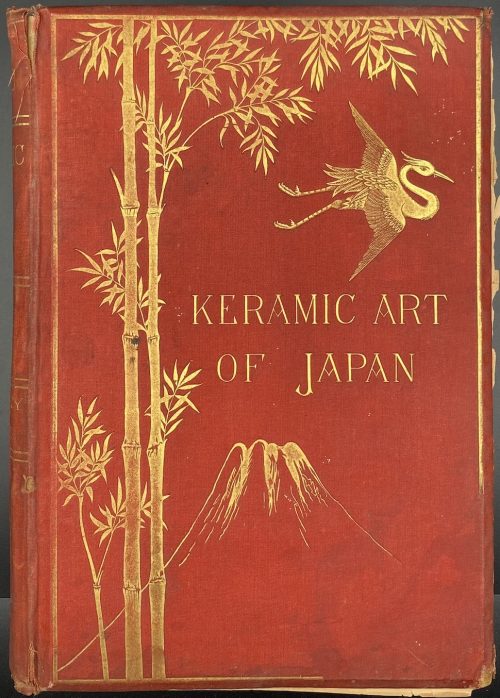 Title-page (in red and black): Keramic art of Japan, | BY | GEORGE A. AUDSLEY | AND | JAMES L. BOWES. | LONDON: HENRY SOTHERAN & CO., | 36 PICADILLY; 136, STRAND; 77 & 78, QUEEN STREET, CITY. | MANCHESTER: 49, CROSS STREET. | MDCCCLXXXI. || Description: 28.5 x 19.5 cm, publisher’s red cloth, bevelled boards, gilt lettering and tooling on front cover and spine, AEG, disbound. 304 p., 10 pl., 32 chromo-lithographed plates. This is the 2nd edition of the 1875 folio edition by the same publisher.. Contents: Introductory essay on Japanese art: p. 1-107; Keramic art of Japan: p. 108-260; Marks and monograms: p. 261-287, Index: p. 288-304. Contributors: George Ashdown Audsley (American, 1838 – 1925) – author. James Lord Bowes (British, 1834 – 1899) – author.
Title-page (in red and black): Keramic art of Japan, | BY | GEORGE A. AUDSLEY | AND | JAMES L. BOWES. | LONDON: HENRY SOTHERAN & CO., | 36 PICADILLY; 136, STRAND; 77 & 78, QUEEN STREET, CITY. | MANCHESTER: 49, CROSS STREET. | MDCCCLXXXI. || Description: 28.5 x 19.5 cm, publisher’s red cloth, bevelled boards, gilt lettering and tooling on front cover and spine, AEG, disbound. 304 p., 10 pl., 32 chromo-lithographed plates. This is the 2nd edition of the 1875 folio edition by the same publisher.. Contents: Introductory essay on Japanese art: p. 1-107; Keramic art of Japan: p. 108-260; Marks and monograms: p. 261-287, Index: p. 288-304. Contributors: George Ashdown Audsley (American, 1838 – 1925) – author. James Lord Bowes (British, 1834 – 1899) – author. -
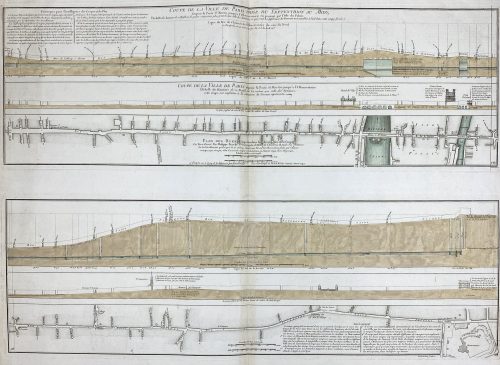
Two prints on one sheet of watermarked laid paper.
Coupe de la ville de Paris prise du septentrion au midy, depuis la porte St Martin jusqu'à l'Observatoire en passant par l'isle du Palais... Coupe de la ville de Paris depuis la porte St Martin jusqu'à l'Observatoire... Plan des rues comprises dans la direction dela coupe... / Le tout dressé par Philippe Buache... ; Desbruslins, sculpsit.
Watermark: "IHS" within circle; countermark of "FIN/ DUPUY/ AUVERGNE 1749".
LOC dates it to 1757. Gallica – to 1742, though the watermark is 1749.
-
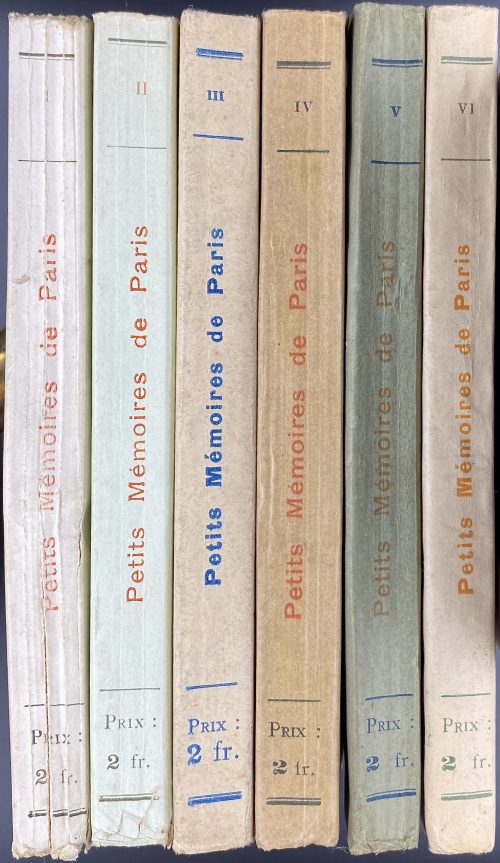 Description: Six softcover volumes, collated in-4to, 14.3 x 10 cm in publisher’s lettered wrappers; printed on laid paper; series "Les petits mémoires de Paris" illustrated with 23 out of 24 etchings by Henri Boutet: (I) Les coulisses de l’amour; (II) Rues et Intérieurs; (III) Le carnet d’un suiveur; (IV) Le petits métiers; (V) Les nuits de Paris; (VI) Toutes les bohêmes. Vol. I: Cream cover, lettered black and red in a black frame: LA MÉSSAGÈRE | LES | PETITS MÉMOIRES | DE | PARIS | CONTENANT | Quatre Eaux-Fortes originales | PAR | Henri BOUTET | I | Les Coulisses de l’Amour | {vignette brown Notre-Dame de Paris} | A PARIS | CHEZ DORBON l’AINÉ, LIBRAIRE | 53 ter, Quai des Grands-Augustins || Title-page: similar, in black, with «MDCCCVIII» in the bottom. Edition not stated. [1-8] ( 7 marked 1) 9-125 [3] contents, colophon; h.t. uncut from 1st blank, three original etchings instead of four (one missing?), incl. frontispiece. Colophon: IMPRIMÉ PAR SOINS | DE LA | SOCIÉTÉ TYPOGRAPHIQUE | DE | CHATEAUDUN || Back wrapper blank. Vol. II: Mint-green cover, lettered black and red in a black frame: LA MÉSSAGÈRE | LES | PETITS MÉMOIRES | DE | PARIS | CONTENANT | Quatre Eaux-Fortes originales | PAR | Henri BOUTET | II | Rues et Intérieurs | {vignette brown Notre-Dame de Paris} | A PARIS | CHEZ DORBON l’AINÉ, LIBRAIRE | 53 ter, Quai des Grands-Augustins || Title-page: similar, in black, with «MDCCCIX» in the bottom. Edition not stated. [1-6] 7-125 [2] contents, colophon (same as in Vol. I); h.t. uncut from 1st blank, four original etchings, incl. frontispiece. Back wrapper blank. Vol. III: Cream cover, lettered blue in a blue frame: LA MÉSSAGÈRE | LES | PETITS MÉMOIRES | DE | PARIS | CONTENANT | Quatre Eaux-Fortes originales | PAR | Henri BOUTET | III | Le Carnet d’un Suiveur | 4e Edition | {vignette smoking gentleman in a top hat} | A PARIS | CHEZ DORBON L’AINÉ, LIBRAIRE | 53 ter, Quai des Grands-Augustins || Title-page: similar, in black, with «MDCCCIX» in the bottom. 4th edition. [1-6] 7-124 [4] contents, colophon (uncut); h.t. uncut from 1st blank, four original etchings, incl. frontispiece. Colophon: Imprimé par soins de | l’Imprimerie de Paris | Têtes de chapitre, lettrines et culs de lampe de | M. Paul Guignebault | Eaux-fortes tirées sous la direction de | M. Henri Boutet || Back wrapper with a frame and a ribbon at center, in blue. Vol. IV: Tan cover, lettered red and black in a black frame: LA MÉSSAGÈRE | LES | PETITS MÉMOIRES | DE | PARIS | CONTENANT | Quatre Eaux-Fortes originales | PAR | Henri BOUTET | IV | Le Petits Métiers | {vignette worker with a ladder} | A PARIS | CHEZ DORBON L’AINÉ, LIBRAIRE | 53 ter, Quai des Grands-Augustins || Title-page: similar, in black, with «MDCCCIX» in the bottom. Edition not stated. [1-6] 7-119 [120 colophon, uncut] [8 advert., uncut]; four original etchings, incl. frontispiece. Colophon: IMPRIMERIE DE PARIS | 22, RUE DES VOLONTAIRES PROLONGÉE | – PARIS - XVe – || Back wrapper with a black frame and a red ribbon at center. Vol. V: Olive-green cover, lettered red and blue in a blue frame: LA MÉSSAGÈRE | LES | PETITS MÉMOIRES | DE | PARIS | CONTENANT | Quatre Eaux-Fortes originales | PAR | Henri BOUTET | V | Les nuits de Paris | Deuxième Édition | {vignette woman on a street} | A PARIS | CHEZ DORBON L’AINÉ, LIBRAIRE | 53 ter, Quai des Grands-Augustins || Title-page: similar, in black, with «MDCDIX» in the bottom. 2nd edition. [1-8] 9-118 [2 colophon, uncut] [8 advert., uncut]; four original etchings, incl. frontispiece. Colophon: IMPRIMERIE DE PARIS | 22, RUE DES VOLONTAIRES PROLONGÉE | – PARIS - XVe – || Back wrapper with a blue frame and a red ribbon at center. Vol. VI: Cream cover, lettered red and blue in a blue frame: LA MÉSSAGÈRE | LES | PETITS MÉMOIRES | DE | PARIS | CONTENANT | Quatre Eaux-Fortes originales | PAR | Henri BOUTET | VI | Toutes les bohêmes | Cinquième Édition | {vignette windmill} | A PARIS | CHEZ DORBON L’AINÉ, LIBRAIRE | 53 ter, Quai des Grands-Augustins || Title-page: similar, in black, with «MDCDIX» in the bottom and “Deuxième Édition”. 5th or 2nd edition. [1-7] 8-120 [2 colophon] [4 advert.] [2 blank]; four original etchings, incl. frontispiece. Colophon: IMPRIMERIE DE PARIS | 22, RUE DES VOLONTAIRES PROLONGÉE | – PARIS - XVe – || Back wrapper with a blue frame and a red ribbon at center. Contributors: Henri Boutet [La Mésangère] (French, 1851 – 1919) – author, artist, etcher. François Louis Dorbon [Dorbon Aîné] (French, 1878 – 1956) – publisher.
Description: Six softcover volumes, collated in-4to, 14.3 x 10 cm in publisher’s lettered wrappers; printed on laid paper; series "Les petits mémoires de Paris" illustrated with 23 out of 24 etchings by Henri Boutet: (I) Les coulisses de l’amour; (II) Rues et Intérieurs; (III) Le carnet d’un suiveur; (IV) Le petits métiers; (V) Les nuits de Paris; (VI) Toutes les bohêmes. Vol. I: Cream cover, lettered black and red in a black frame: LA MÉSSAGÈRE | LES | PETITS MÉMOIRES | DE | PARIS | CONTENANT | Quatre Eaux-Fortes originales | PAR | Henri BOUTET | I | Les Coulisses de l’Amour | {vignette brown Notre-Dame de Paris} | A PARIS | CHEZ DORBON l’AINÉ, LIBRAIRE | 53 ter, Quai des Grands-Augustins || Title-page: similar, in black, with «MDCCCVIII» in the bottom. Edition not stated. [1-8] ( 7 marked 1) 9-125 [3] contents, colophon; h.t. uncut from 1st blank, three original etchings instead of four (one missing?), incl. frontispiece. Colophon: IMPRIMÉ PAR SOINS | DE LA | SOCIÉTÉ TYPOGRAPHIQUE | DE | CHATEAUDUN || Back wrapper blank. Vol. II: Mint-green cover, lettered black and red in a black frame: LA MÉSSAGÈRE | LES | PETITS MÉMOIRES | DE | PARIS | CONTENANT | Quatre Eaux-Fortes originales | PAR | Henri BOUTET | II | Rues et Intérieurs | {vignette brown Notre-Dame de Paris} | A PARIS | CHEZ DORBON l’AINÉ, LIBRAIRE | 53 ter, Quai des Grands-Augustins || Title-page: similar, in black, with «MDCCCIX» in the bottom. Edition not stated. [1-6] 7-125 [2] contents, colophon (same as in Vol. I); h.t. uncut from 1st blank, four original etchings, incl. frontispiece. Back wrapper blank. Vol. III: Cream cover, lettered blue in a blue frame: LA MÉSSAGÈRE | LES | PETITS MÉMOIRES | DE | PARIS | CONTENANT | Quatre Eaux-Fortes originales | PAR | Henri BOUTET | III | Le Carnet d’un Suiveur | 4e Edition | {vignette smoking gentleman in a top hat} | A PARIS | CHEZ DORBON L’AINÉ, LIBRAIRE | 53 ter, Quai des Grands-Augustins || Title-page: similar, in black, with «MDCCCIX» in the bottom. 4th edition. [1-6] 7-124 [4] contents, colophon (uncut); h.t. uncut from 1st blank, four original etchings, incl. frontispiece. Colophon: Imprimé par soins de | l’Imprimerie de Paris | Têtes de chapitre, lettrines et culs de lampe de | M. Paul Guignebault | Eaux-fortes tirées sous la direction de | M. Henri Boutet || Back wrapper with a frame and a ribbon at center, in blue. Vol. IV: Tan cover, lettered red and black in a black frame: LA MÉSSAGÈRE | LES | PETITS MÉMOIRES | DE | PARIS | CONTENANT | Quatre Eaux-Fortes originales | PAR | Henri BOUTET | IV | Le Petits Métiers | {vignette worker with a ladder} | A PARIS | CHEZ DORBON L’AINÉ, LIBRAIRE | 53 ter, Quai des Grands-Augustins || Title-page: similar, in black, with «MDCCCIX» in the bottom. Edition not stated. [1-6] 7-119 [120 colophon, uncut] [8 advert., uncut]; four original etchings, incl. frontispiece. Colophon: IMPRIMERIE DE PARIS | 22, RUE DES VOLONTAIRES PROLONGÉE | – PARIS - XVe – || Back wrapper with a black frame and a red ribbon at center. Vol. V: Olive-green cover, lettered red and blue in a blue frame: LA MÉSSAGÈRE | LES | PETITS MÉMOIRES | DE | PARIS | CONTENANT | Quatre Eaux-Fortes originales | PAR | Henri BOUTET | V | Les nuits de Paris | Deuxième Édition | {vignette woman on a street} | A PARIS | CHEZ DORBON L’AINÉ, LIBRAIRE | 53 ter, Quai des Grands-Augustins || Title-page: similar, in black, with «MDCDIX» in the bottom. 2nd edition. [1-8] 9-118 [2 colophon, uncut] [8 advert., uncut]; four original etchings, incl. frontispiece. Colophon: IMPRIMERIE DE PARIS | 22, RUE DES VOLONTAIRES PROLONGÉE | – PARIS - XVe – || Back wrapper with a blue frame and a red ribbon at center. Vol. VI: Cream cover, lettered red and blue in a blue frame: LA MÉSSAGÈRE | LES | PETITS MÉMOIRES | DE | PARIS | CONTENANT | Quatre Eaux-Fortes originales | PAR | Henri BOUTET | VI | Toutes les bohêmes | Cinquième Édition | {vignette windmill} | A PARIS | CHEZ DORBON L’AINÉ, LIBRAIRE | 53 ter, Quai des Grands-Augustins || Title-page: similar, in black, with «MDCDIX» in the bottom and “Deuxième Édition”. 5th or 2nd edition. [1-7] 8-120 [2 colophon] [4 advert.] [2 blank]; four original etchings, incl. frontispiece. Colophon: IMPRIMERIE DE PARIS | 22, RUE DES VOLONTAIRES PROLONGÉE | – PARIS - XVe – || Back wrapper with a blue frame and a red ribbon at center. Contributors: Henri Boutet [La Mésangère] (French, 1851 – 1919) – author, artist, etcher. François Louis Dorbon [Dorbon Aîné] (French, 1878 – 1956) – publisher. -
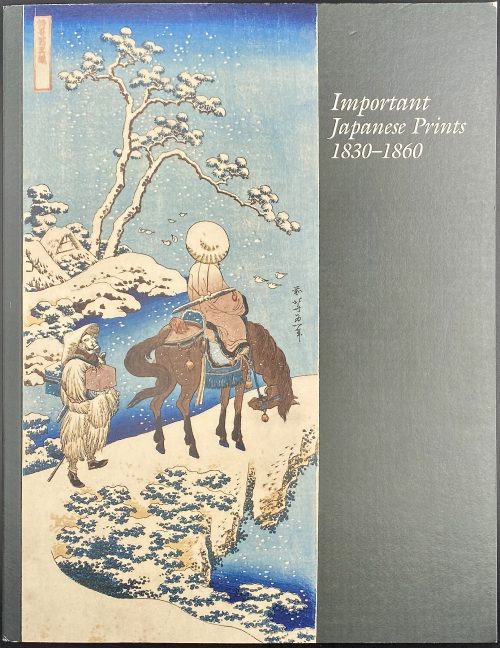 Softcover, in pictorial wrappers, 28 x 22 cm, 67 items, with colour illustrations, some folding. Catalogue of the sales exhibition on March 14-20, 2020 in NY; pagination: [1-3] 4-120 [8], ils. 6 fan prints. Contributor: Sebastian Izzard
Softcover, in pictorial wrappers, 28 x 22 cm, 67 items, with colour illustrations, some folding. Catalogue of the sales exhibition on March 14-20, 2020 in NY; pagination: [1-3] 4-120 [8], ils. 6 fan prints. Contributor: Sebastian Izzard -
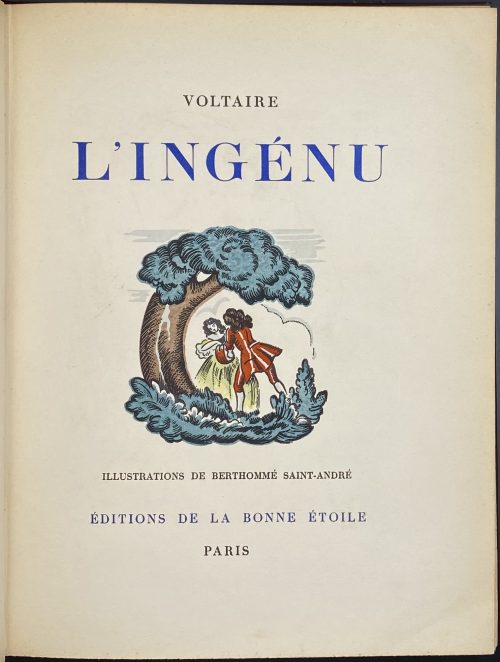 Description: One volume, 27 x 21.5 cm, collated 4to, bound in full dark crimson calf with gilt floral border, raised bands with gilt filets, gilt lettering to spine, 16 colour plates, one of them loose, and numerous woodcut tailpieces. Title-page: (black and blue): VOLTAIRE | L'INGÉNU | {VIGNETTE} | ILLUSTRATIONS DE BERTHOMMÉ SAINT-ANDRÉ | ÉDITIONS DE LA BONNE ÉTOILE | PARIS || Collation: 4to; π4 (2 blanks, h.t./limitation, t.p.), 1-184, last blank; total 76 leaves plus 16 colour plates after Louis Berthommé Saint-André and two flyleaves, first and last. Pagination: [4 blanks] [1-4] 5-143 [144] [4 blanks]; total 152 pages, ils. Limitation: Edition limited to 2,500 copies, of which this is copy № 1621. Colophon: Printed under direction of Paul Cotinaud at L’Union Typographique by Henri Leduc; photogravures executed by G. Duval and coloured by E. Vairel fils. Contributors: François Marie Arouet de Voltaire (French, 1694 – 1778) – author. Louis Berthomme Saint-André (French, 1905 – 1977) – artist.
Description: One volume, 27 x 21.5 cm, collated 4to, bound in full dark crimson calf with gilt floral border, raised bands with gilt filets, gilt lettering to spine, 16 colour plates, one of them loose, and numerous woodcut tailpieces. Title-page: (black and blue): VOLTAIRE | L'INGÉNU | {VIGNETTE} | ILLUSTRATIONS DE BERTHOMMÉ SAINT-ANDRÉ | ÉDITIONS DE LA BONNE ÉTOILE | PARIS || Collation: 4to; π4 (2 blanks, h.t./limitation, t.p.), 1-184, last blank; total 76 leaves plus 16 colour plates after Louis Berthommé Saint-André and two flyleaves, first and last. Pagination: [4 blanks] [1-4] 5-143 [144] [4 blanks]; total 152 pages, ils. Limitation: Edition limited to 2,500 copies, of which this is copy № 1621. Colophon: Printed under direction of Paul Cotinaud at L’Union Typographique by Henri Leduc; photogravures executed by G. Duval and coloured by E. Vairel fils. Contributors: François Marie Arouet de Voltaire (French, 1694 – 1778) – author. Louis Berthomme Saint-André (French, 1905 – 1977) – artist. -
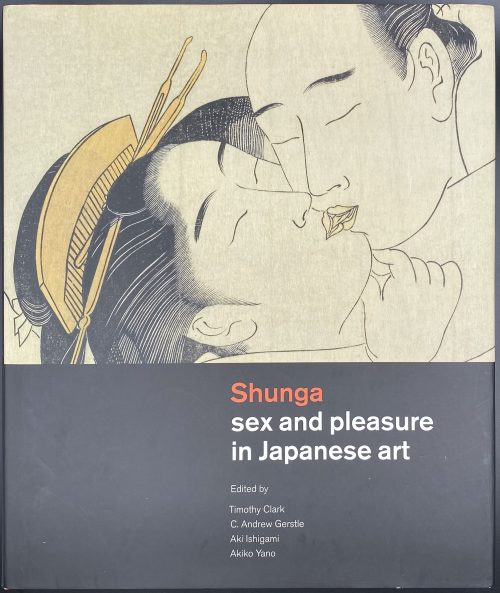 Hardcover volume, 29.6 x 25 x 4 cm, in red cloth with black lettering to spine, in pictorial dust jacket, profusely illustrated in colour; pp.: [1-6] 7-536, total 268 leaves and 2 folding plates extraneous to collation. Title-page: {Hotei's device} Hotei Publishing | Shunga | sex and pleasure in Japanese art | Edited by | Timothy Clark | C. Andrew Gerstle | Aki Ishigami | Akiki Yano || Contents: The Cultural Historical Significance and Importance of Japanese Shunga / Kobayashi Tadashi. Introduction: What Was Shunga? / C. Andrew Gerstle; Who Were the Audiences for Shunga? / Hayakawa Monta. (1) Early Shunga before 1765: Shunga Paintings before the `Floating World' / Akiko Yano; Chinese Chunhua and Japanese Shunga / Ishigami Aki; Shunga and the Rise of Print Culture / Asano Shugo. (2) Masterpieces of Shunga 1765-1850: The Essence of Ukiyo-e Shunga / Kobayashi Tadashi; Erotic Books as Luxury Goods / Ellis Tinios; Listening to the Voices in Shunga / Hayakawa Monta; The Tale of Genji in Shunga / Sato Satoru. (3) Censorship: Timeline of Censorship; Shunga and Censorship in the Edo Period (1600-1868) / Jennifer Preston; Graph of approximate output of shunga print series and books; The Censorship of Shunga in the Modern Era / Ishigami Aki; Shunga Studies in the Showa Era (1926-89) / Shirakura Yoshihiko. (4) Contexts for Shunga: Traditional Uses of Shunga / Yamamoto Yukari; The Distribution and Circulation of Erotic Prints and Books in the Edo Period Laura Moretti; Shunga and Parody / C. Andrew Gerstle; Popular Cults of Sex Organs in Japan / Suzuki Kenko; Grotesque Shunga / Ishigami Aki; Violence in Shunga / Higuchi Kazutaka; Foreign Connections in Shunga / Timon Screech; Children in Shunga / Akiko Yano; Shunga and the Floating World / Matsuba Ryoko. (5) Shunga in the Meiji Era: Erotic Art of the Meiji Era (1868-1912) / Rosina Buckland; The Modern West's Discovery of Shunga / Ricard Bru. Published to accompany the exhibition Shunga: sex and pleasure in Japanese art at the British Museum from 3 October 2013 to 5 January 2014. Abstract: This catalogue aims to answer some key questions about what is shunga and why it was produced. In particular, the social and cultural contexts for sex art in Japan are explored. Erotic Japanese art was heavily suppressed in Japan from the 1870s onwards as part of a process of cultural 'modernisation' that imported many contemporary western moral values. Only in the last twenty years or so has it been possible to publish unexpurgated examples in Japan and this landmark book places erotic Japanese art in its historical and cultural context for the first time. This book looks at painted and printed erotic images produced in Japan during the Edo period (1600-1868) and early Meiji era (1868-1912). These are related to the wider contexts of literature, theatre, the culture of the pleasure quarters, and urban consumerism; and interpreted in terms of their sensuality, reverence, humour and parody. Contributors: Timothy Clark (British, b. 1959) Timothy Clark (British, b. 1959) C. Andrew Gerstle (American, 1951) Aki Ishigami [石上阿希] (Japanese) Akiki Yano
Hardcover volume, 29.6 x 25 x 4 cm, in red cloth with black lettering to spine, in pictorial dust jacket, profusely illustrated in colour; pp.: [1-6] 7-536, total 268 leaves and 2 folding plates extraneous to collation. Title-page: {Hotei's device} Hotei Publishing | Shunga | sex and pleasure in Japanese art | Edited by | Timothy Clark | C. Andrew Gerstle | Aki Ishigami | Akiki Yano || Contents: The Cultural Historical Significance and Importance of Japanese Shunga / Kobayashi Tadashi. Introduction: What Was Shunga? / C. Andrew Gerstle; Who Were the Audiences for Shunga? / Hayakawa Monta. (1) Early Shunga before 1765: Shunga Paintings before the `Floating World' / Akiko Yano; Chinese Chunhua and Japanese Shunga / Ishigami Aki; Shunga and the Rise of Print Culture / Asano Shugo. (2) Masterpieces of Shunga 1765-1850: The Essence of Ukiyo-e Shunga / Kobayashi Tadashi; Erotic Books as Luxury Goods / Ellis Tinios; Listening to the Voices in Shunga / Hayakawa Monta; The Tale of Genji in Shunga / Sato Satoru. (3) Censorship: Timeline of Censorship; Shunga and Censorship in the Edo Period (1600-1868) / Jennifer Preston; Graph of approximate output of shunga print series and books; The Censorship of Shunga in the Modern Era / Ishigami Aki; Shunga Studies in the Showa Era (1926-89) / Shirakura Yoshihiko. (4) Contexts for Shunga: Traditional Uses of Shunga / Yamamoto Yukari; The Distribution and Circulation of Erotic Prints and Books in the Edo Period Laura Moretti; Shunga and Parody / C. Andrew Gerstle; Popular Cults of Sex Organs in Japan / Suzuki Kenko; Grotesque Shunga / Ishigami Aki; Violence in Shunga / Higuchi Kazutaka; Foreign Connections in Shunga / Timon Screech; Children in Shunga / Akiko Yano; Shunga and the Floating World / Matsuba Ryoko. (5) Shunga in the Meiji Era: Erotic Art of the Meiji Era (1868-1912) / Rosina Buckland; The Modern West's Discovery of Shunga / Ricard Bru. Published to accompany the exhibition Shunga: sex and pleasure in Japanese art at the British Museum from 3 October 2013 to 5 January 2014. Abstract: This catalogue aims to answer some key questions about what is shunga and why it was produced. In particular, the social and cultural contexts for sex art in Japan are explored. Erotic Japanese art was heavily suppressed in Japan from the 1870s onwards as part of a process of cultural 'modernisation' that imported many contemporary western moral values. Only in the last twenty years or so has it been possible to publish unexpurgated examples in Japan and this landmark book places erotic Japanese art in its historical and cultural context for the first time. This book looks at painted and printed erotic images produced in Japan during the Edo period (1600-1868) and early Meiji era (1868-1912). These are related to the wider contexts of literature, theatre, the culture of the pleasure quarters, and urban consumerism; and interpreted in terms of their sensuality, reverence, humour and parody. Contributors: Timothy Clark (British, b. 1959) Timothy Clark (British, b. 1959) C. Andrew Gerstle (American, 1951) Aki Ishigami [石上阿希] (Japanese) Akiki Yano -
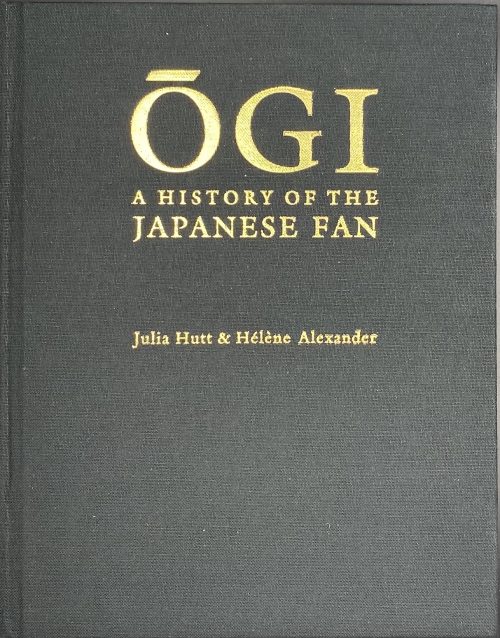 Hardcover, 29.7 x 23.7 cm, black cloth with gilt lettering to front cover and spine, pictorial dust jacket, gilt slipcase; pp.: [1-4] 5-112, ils.; 97 catalogue entries. Exhibition “Fans of the four seasons” and The Fan Museum, Greenwich. Contributors: Julia Hutt Hélène Alexander
Hardcover, 29.7 x 23.7 cm, black cloth with gilt lettering to front cover and spine, pictorial dust jacket, gilt slipcase; pp.: [1-4] 5-112, ils.; 97 catalogue entries. Exhibition “Fans of the four seasons” and The Fan Museum, Greenwich. Contributors: Julia Hutt Hélène Alexander -
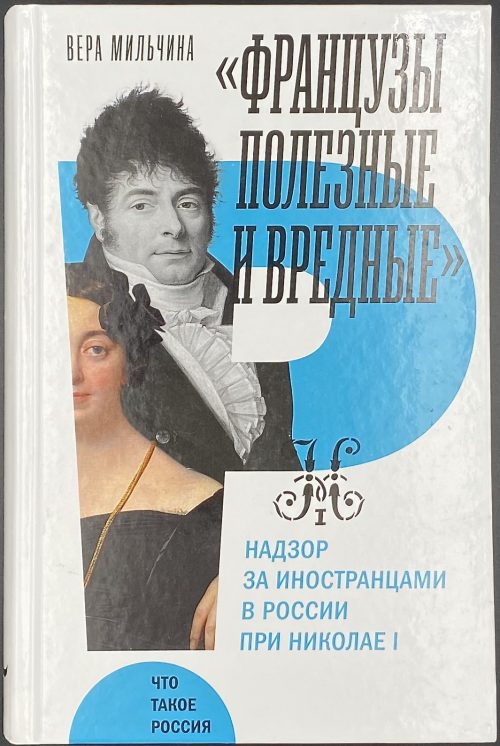 Description: One volume, 20.6 x 13.7 cm, pictorial glossy paper boards; pp.: [1-6] 7-480 [481] [7 advert.]; total 488 pages, ils. ISBN: 978-5-4448-0627-2. Contributor: Вера Аркадьевна Мильчина [Vera Miltchina] (Russian, b. 1953)
Description: One volume, 20.6 x 13.7 cm, pictorial glossy paper boards; pp.: [1-6] 7-480 [481] [7 advert.]; total 488 pages, ils. ISBN: 978-5-4448-0627-2. Contributor: Вера Аркадьевна Мильчина [Vera Miltchina] (Russian, b. 1953) -
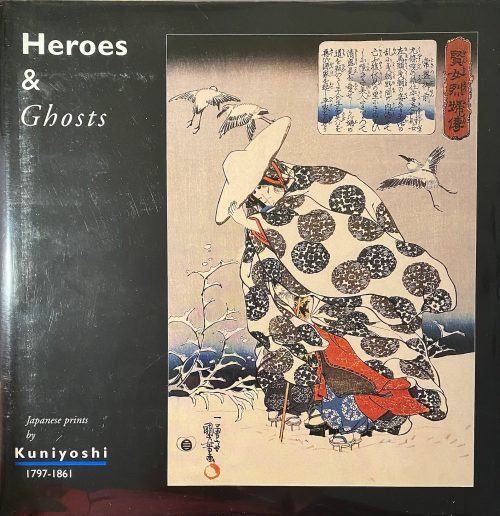 Title-page: Heroes & Ghosts | Japanese prints | by | Kuniyoshi | 1797-1861 | [space] | Robert Schaap | introduction by | Amy Reigle Newland | essays by | Timothy T. Clark | Matthi Forrer | Inagaki Shin'ichi | {publisher’s device} | Hotei Publishing, Leiden | Society for Japanese Arts || Description: Square hardcover volume, 29.3 x 29 cm, bound in black cloth with blind vignette to front cover and blind lettering to spine, black pictorial endpapers, pictorial dust jacket; pp.: [1-4] 5-280, incl. 279 plates and 31 figures in the text; based on exhibit in Van Gogh Museum (Amsterdam) 30 Jan – 5 Apr 1998 and Philadelphia Museum of Art (Philadelphia) 24 Apr – 29 Jun 1998.
Title-page: Heroes & Ghosts | Japanese prints | by | Kuniyoshi | 1797-1861 | [space] | Robert Schaap | introduction by | Amy Reigle Newland | essays by | Timothy T. Clark | Matthi Forrer | Inagaki Shin'ichi | {publisher’s device} | Hotei Publishing, Leiden | Society for Japanese Arts || Description: Square hardcover volume, 29.3 x 29 cm, bound in black cloth with blind vignette to front cover and blind lettering to spine, black pictorial endpapers, pictorial dust jacket; pp.: [1-4] 5-280, incl. 279 plates and 31 figures in the text; based on exhibit in Van Gogh Museum (Amsterdam) 30 Jan – 5 Apr 1998 and Philadelphia Museum of Art (Philadelphia) 24 Apr – 29 Jun 1998. -
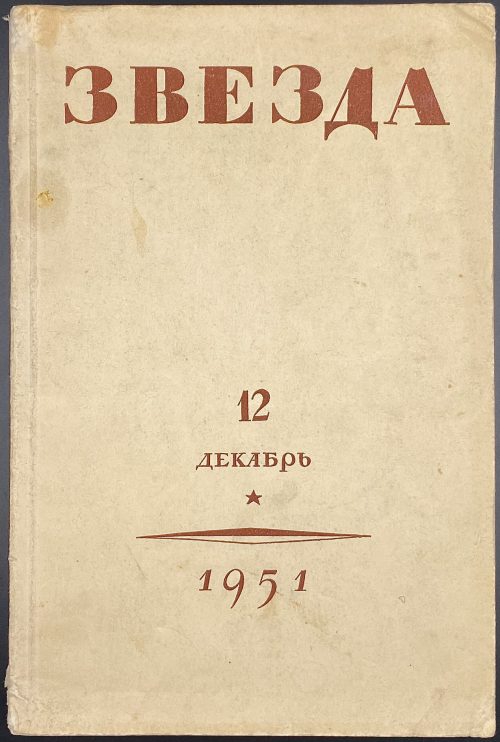 Sergei Petrovich Varshavsky [Сергей Петрович Варшавский] (Jewish-Russian, 1906 – 1980). B. Rest [Б. Рест; Юлий Исаакович Шапиро] (Jewish-Russian, fl. 1940 – 1980). Monthly magazine Star ("Звезда", Zvezda) published from 1924; circulation of 60,000 copies. Editor-in-Chief: Валерий Павлович Друзин (Russian, 1903 – 1980). Softcover, original wrappers, 25.3 x 16.8 cm, pp.: [2] 3-190 [2], total 192 pages; collated 8vo: [1]-128, total 96 leaves.
Sergei Petrovich Varshavsky [Сергей Петрович Варшавский] (Jewish-Russian, 1906 – 1980). B. Rest [Б. Рест; Юлий Исаакович Шапиро] (Jewish-Russian, fl. 1940 – 1980). Monthly magazine Star ("Звезда", Zvezda) published from 1924; circulation of 60,000 copies. Editor-in-Chief: Валерий Павлович Друзин (Russian, 1903 – 1980). Softcover, original wrappers, 25.3 x 16.8 cm, pp.: [2] 3-190 [2], total 192 pages; collated 8vo: [1]-128, total 96 leaves. -
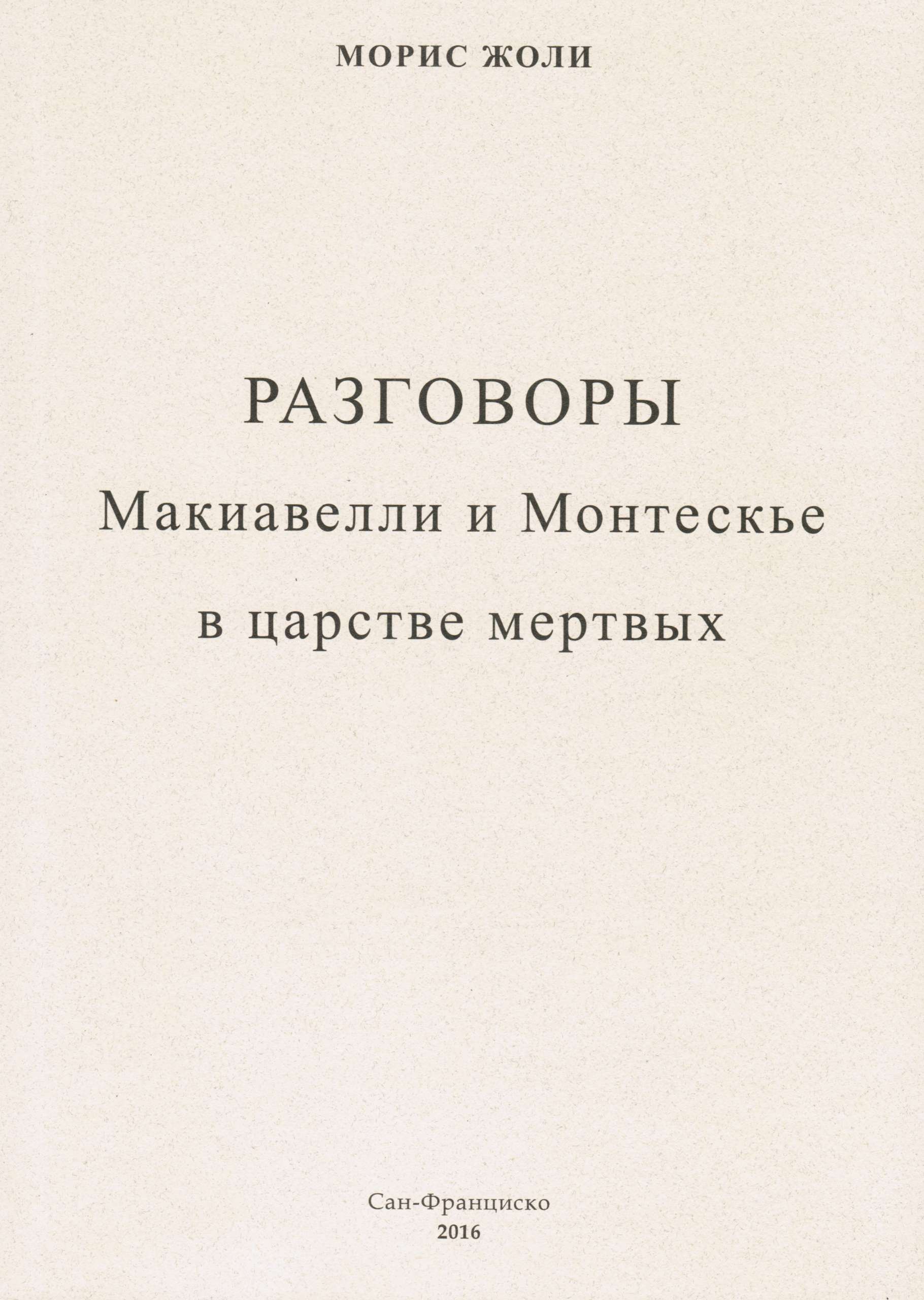
"Разговоры Макиавелли и Монтескье в царстве мертвых” (Dialogue aux Enfers entre Machiavel et Montesquieu) – это политический памфлет, направленный против Наполена III. В 25 диалогах представитель эпохи Просвещения благородный барон де Монтескье отстаивает позиции умеренного правления и соблюдения прав личности, а флорентийский политик Средневековья злокозненный Макиавелли берется доказать своему собеседнику, что управлять людьми можно только силой и хитростью, и что деспотия — это потребность современного общества. Собеседники заключают пари. Макиавелли шаг за шагом описывает те действия, которые предпринял Наполеон III для установления деспотии во Франции, и выигрывает пари.
В начале XX века «Разговоры» Жоли были использованы в царской России для изготовления антисемитской фальшивки — печально знаменитых «Протоколов сионских мудрецов», книги, переведенной на все языки мира и своими тиражами уступающей только Библии. Плагиат был разоблачен корреспондентом газеты «Таймс» Филипом Грейвсом в 1921 г. Сравнением текстов “Разговоров” и “Протоколов”, равно как и поиском автора плагиата, занималось не одно поколение исследователей. В наше время о “Разговорах” знают в основном благодаря “Протоколам”, но книга Жоли представляет интерес отнюдь не только в связи с означенными “Протоколами”. Единственный до сих пор перевод “Разговоров” на русский язык был выпущен в 2004 году издательством “МК-Трейд” под названием “Диалог в аду между Макиавелли и Монтескье”. Это был перевод с немецкого перевода с французского языка. Предлагаемое читателю новое издание книги Жоли является переводом с французского оригинала, хотя и достаточно вольным, что отражено в заголовке: Разговоры Макиавелли и Монтескье в царстве мертвых, записанные злосчастным французом Морисом Жоли в правление императора Людовика-Наполеона и пересказанные полтора века спустя для русского читателя нашим современником. Морис Жоли писал о “политике макиавеллизма в XIX веке”. Однако теперь очевидно, что и в XXI веке политика макиавеллизма не претерпела существенных изменений. Старинный рецепт установления деспотии “в одной, отдельно взятой стране” хорош и по сей день.Published in San Francisco, California.
Paperback, size: 110 x 148 x 10 mm
-

Iron tsuba of round form decorated with design of keys to the storehouse of the gods in openwork (sukashi). Rounded rim. Copper sekigane.
Unsigned. Early Edo period, 17th century.
Size: 71.0 x 70.9 x 6.0 mm.Merrily Baird, Symbols..: The Key to the Storehouse of the Gods, one of the Myriad Treasures.
-

Iron tsuba of oval form pierced with design of slanting rays of light (shakoh), a Christian motif (Jesuit’s IHS symbol), and a pair of tassels in positive silhouette (ji-sukashi). Details on tassels carved in low relief. Traditional description of this kind of design is called “tokei”, or “clock gear”. Rounded rim.
Unsigned.
Edo period, 17th or 18th century. Possibly - Owari school.
Size: 76.0 x 73.0 x 6.2 mm. -

Sentoku tsuba of oval form with Sennin (Chinese immortal) motif carved in low relief (katakiribori). The Sennin is depicted with a double gourd in his right hand and a child beside his left hip. A pine tree carved on the reverse.
Signed: Sōmin saku (宗眠作) [M.Sesko]. Yokoya School (see The Japanese toso-kinko Schools by Markus Sesko, pp. 133-8).
Edo period (second half of the 18th century). Dimensions: Height: 61.6 mm; Width: 56.4 mm; Thickness: 4.2 mm; Weight: 85 g. -

Large oval form tsuba decorated with two human figures (scholar and attendant) under the pine tree admiring a view of a waterfall on the face of the plate, and with stylized dragons carved on the reverse among the symbols of thunder inlaid in gold. The plate is carved in low relief with details inlaid with gold and silver.
Signed: Yamashiro no kuni Fushimi no ju Kaneie [Kaneie of Fushimi in Yamashiro Province] [山城國伏見住金家], with Kaō. It is a fake signature (
gimei). Size: Height: 91.9 mm; Width: 85.6 mm; Thickness: 3.4 mm; Weight: 169 g.
This is a late Edo period, 19th-century export work to cater to the tastes of the European tsuba collectors. It does not have anything in common with the work of great Kaneie masters.
SOLD -
 Silver Kozuka carved in kebori ("hair carving") with a ukiyo-e style half-length figure of a beautiful woman (possibly a courtesan) dressed in a splendid kimono and hair ornament (kanzashi). Signed on the back: Koreyasu/Zetai + kaō (是休「花押」) - transcribed by Markus Sesko. Size: 96.8 mm (H) x 14.9 mm (W). Edo period, early 19th century. I managed so far to find the only mention of Koreyasu at Japanese sword-mounts. A descriptive catalogue of the collection of J. C. Hawkshaw, Esq., M.A., of Hollycombe, Liphook. Complied and illustrated by Henri L. Joly. London, 1910 [LIB-1439 in this collection], page 204: 2623. — F./v., nigurome, chased in relief and inlaid with Omori Hikoshichi (large faces). Signed : Koreyasu of Yedo. xix. 2624. — F.K., nigurome, chased and inlaid in relief with Omori Hikoshichi and the witch. Signed : Shinriusha Koreyasu. No pictures of items or signature provided.
Silver Kozuka carved in kebori ("hair carving") with a ukiyo-e style half-length figure of a beautiful woman (possibly a courtesan) dressed in a splendid kimono and hair ornament (kanzashi). Signed on the back: Koreyasu/Zetai + kaō (是休「花押」) - transcribed by Markus Sesko. Size: 96.8 mm (H) x 14.9 mm (W). Edo period, early 19th century. I managed so far to find the only mention of Koreyasu at Japanese sword-mounts. A descriptive catalogue of the collection of J. C. Hawkshaw, Esq., M.A., of Hollycombe, Liphook. Complied and illustrated by Henri L. Joly. London, 1910 [LIB-1439 in this collection], page 204: 2623. — F./v., nigurome, chased in relief and inlaid with Omori Hikoshichi (large faces). Signed : Koreyasu of Yedo. xix. 2624. — F.K., nigurome, chased and inlaid in relief with Omori Hikoshichi and the witch. Signed : Shinriusha Koreyasu. No pictures of items or signature provided. -

Iron tsuba of round form decorated with the design of distant pines, torii, and crescent moon in openwork (sukashi). Copper sekigane.
Size: 84.9 x 84.8 x 5.8 mm.
Unsigned.
Edo period, ca. 1750.
Tosa Myochin or Akasaka school.Japanese Swords and Sword Fittings from the Collection of Dr. Walter Ames Compton (Part I). Christie's, New York, March 31, 1992, pp. 28-29, № 53:
"A Tosa Myochin School Tsuba. Edo period (circa 1750), signed Toshu ju Kuniyoshi saku. The round iron plate pierced with a design of a temple gate (torii) and a pine tree. It has a round rim and there are some carved details on the surface of the design. The Tosa Myochin school, despite its foundation in the classic Myochin armor school tradition, worked mainly in the style of Akasaka school of Edo. [...] Many are equal to the mid to later Akasaka school work and the two types have frequently been confused. Signed examples are rare. Estimated price $1,500-2,000."

Compton Collection, Vol. 1, №53
-

Iron tsuba of circular form with a branch of loquat (biwa) pierced in positive silhouette (ji-sukashi) and carved in marubori technique (marubori-sukashi). Kozuka and kogai hitsu-ana are plugged with shakudo.
Signature: Choshu Kawaji ju Hisatsugu saku. Chōshū school in Nagato province.
According to M. Sesko 'Genealogies' Hisatsugu was a 4th generation Kawaji School master from Chōshū (present day Nagato), with the name Gonbei, formerly Toramatsu, adopted son of Tomohisa (1687-1743) [page 117]. For Tomohisa work see TSU-0104 in this collection. -

Iron tsuba of mokkō-form with a pine and a frog on the face and a snail on the back, carved and inlaid with gold. Each figurative element of the design is signed on three inlaid cartouches: Masaharu (正春), Kazuyuki (一之), and Yoshikazu (良一) [read by Markus Sesko]. Snake, snail, and frog together make a design called "SANSUKUMI" - Three Cringing Ones [Merrily Baird]. The snail can poison the snake, the frog eats the snail, and the snake eats the frog. It's unclear whether the pine replaces the snake on this tsuba, or the snake is hiding in the pine? Anyway, the frog and the snail are clearly represented. "Maybe we have here a joint work with Masaharu (the silver cartouche next to the pine) being the master and making the plate and Kazuyuki and Yoshikazu as his students carving out the frog and the snail respectively". Copper sekigane.
Dimensions: 70.9 x 67.2 x 3.0 mm. Edo period (18th century).Markus Sesko writes: "I agree, the frog and the snail most likely allude to the san-sukumi motif. It is possible that we have here an artist's choice to deliberately leave out the snake, maybe he thought that the motif is already obvious and there is no need to add a snake to make it clear that the tsuba shows the san-sukumi motif." [Markus Sesko].
Kazuyuki (一之): adopted son of Kumagai Yoshiyuki, student of Ichijō (Gotō-Ichijō Scool) [M. Sesko 'Genealogies', page 19.] Masaharu (正春): Kasuya fam., student of Masamichi (1707-1757) who was the 4th generation Nomura School master in Edo. [M. Sesko 'Genealogies', page 49.] -

Iron tsuba pierced and carved (marubori-sukashi) with the 'horse in the round' design. Possibly, Bushū-Ito school, 19th century (ca. 1800). Kogai-hitsu-ana plugged with shakudō.
Size: 67.6 x 66.8 x 5.1 mm
Unsigned.
See:
-
- Robert E. Haynes. Study Collection of Japanese Sword Fittings. Nihon Art Publishers, 2010, p. 120: Iron plate carved and formed in the round as a tethered bull...Signed: Bushū jū Sadayasu saku.
- Robert E. Haynes. Masterpiece and highly important tsuba, etc... San Francisco, 1984 // Catalog #9.: Signed: Bushū jū Yoshifusa. Ca. 1800, H 6.7 cm, Th. 4.75 mm.
- The Hartman collection of Japanese metalwork. Christie's, 1976, p. 29, №59: Bushū type, 19th century. Reference to Takezawa, Nihon Toban Zuetsu №411 for a similar design signed Bushū Yoshifusa.
4. Japanese Sword Fittings from the R. B. Caldwell Collection. Sale LN4188 "HIGO". Sotheby's, 30th March 1994, p. 17, №24: An iron tsuba, by Heianjo Sadatsune, Edo period (18th century). In the form of a horse, standing with its head lowered and a rope halter attached to its bit and trailing beneath. Signed Heianjo Sadatsune, 7.3 cm. With NBTHK Tokubetsu kicho paper, dated Showa 49 (1974). GBP 600-700.
Hartman collection, №59.

The Caldwell Collection. Heianjo Sadatsune, Edo period (18th century).
-


